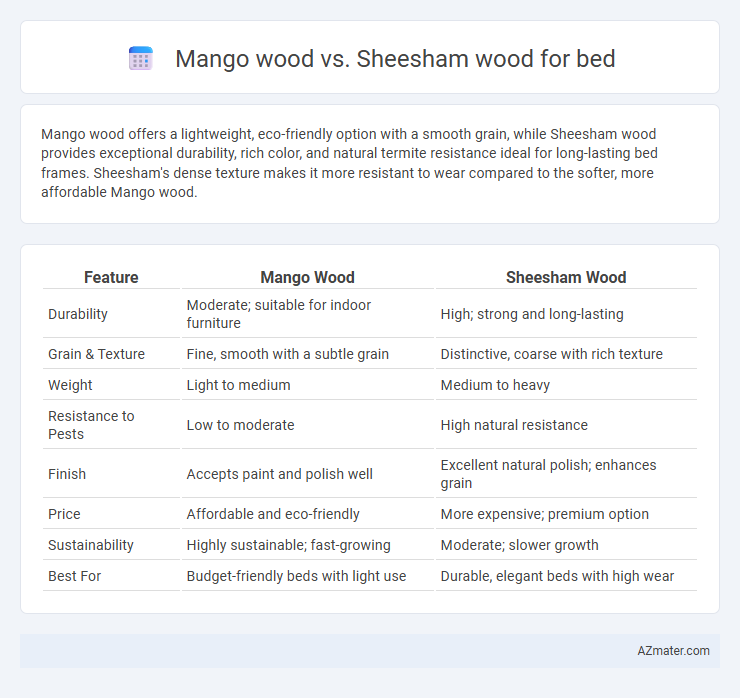Mango wood offers a lightweight, eco-friendly option with a smooth grain, while Sheesham wood provides exceptional durability, rich color, and natural termite resistance ideal for long-lasting bed frames. Sheesham's dense texture makes it more resistant to wear compared to the softer, more affordable Mango wood.
Table of Comparison
| Feature | Mango Wood | Sheesham Wood |
|---|---|---|
| Durability | Moderate; suitable for indoor furniture | High; strong and long-lasting |
| Grain & Texture | Fine, smooth with a subtle grain | Distinctive, coarse with rich texture |
| Weight | Light to medium | Medium to heavy |
| Resistance to Pests | Low to moderate | High natural resistance |
| Finish | Accepts paint and polish well | Excellent natural polish; enhances grain |
| Price | Affordable and eco-friendly | More expensive; premium option |
| Sustainability | Highly sustainable; fast-growing | Moderate; slower growth |
| Best For | Budget-friendly beds with light use | Durable, elegant beds with high wear |
Introduction: Mango Wood vs Sheesham Wood for Beds
Mango wood and Sheesham wood differ significantly in durability and aesthetics when used for beds. Mango wood offers a lighter, affordable option with unique grain patterns but is less dense and more prone to scratches. Sheesham wood, also known as Indian rosewood, provides superior strength, rich color, and natural resistance to pests, making it ideal for long-lasting, high-quality beds.
Origin and Botanical Overview
Mango wood, derived from the Mangifera indica tree native to South Asia, is a sustainable hardwood known for its dense grain and golden-brown color. Sheesham wood, sourced from the Dalbergia sissoo tree indigenous to the Indian subcontinent, is prized for its durability, rich dark hue, and natural resistance to decay. Both woods are popular choices for bed frames due to their strength and unique botanical characteristics, with Mango wood offering a more affordable and eco-friendly option compared to the traditionally prized Sheesham wood.
Appearance and Grain Patterns
Mango wood features a warm, golden-yellow hue with occasional darker streaks, showcasing a distinct fine and uniform grain pattern that adds a subtle elegance to bed frames. Sheesham wood, also known as Indian rosewood, displays rich brown tones with dramatic, swirling grain patterns and natural luster, creating a bold, luxurious appearance for bedroom furniture. The contrast between mango wood's consistent, light texture and sheesham's intricate, darker grains makes each wood type suitable for different aesthetic preferences in bed design.
Durability and Strength Comparison
Mango wood is moderately durable with a density of approximately 640 kg/m3, making it suitable for lightweight bed frames but prone to dents and scratches over time. Sheesham wood, also known as Indian rosewood, boasts a higher density around 830 kg/m3 and exceptional hardness, offering superior strength and resistance to wear, ideal for long-lasting bed construction. The natural oils in Sheesham wood provide extra protection against pests and moisture, enhancing its durability compared to mango wood.
Sustainability and Environmental Impact
Mango wood is a sustainable choice for beds since it utilizes timber from mango trees that have ceased fruit production, reducing deforestation and waste. Sheesham wood, also known as Indian rosewood, is a durable hardwood but its slow growth rate and high demand contribute to environmental concerns and illegal logging in some regions. Choosing mango wood supports eco-friendly practices by repurposing agricultural by-products and minimizes the carbon footprint associated with harvesting slower-growing hardwoods like sheesham.
Cost and Affordability
Mango wood is generally more affordable than Sheesham wood, making it a cost-effective option for bed frames without compromising durability. Sheesham wood, known for its rich grain and natural resistance to termites, commands a higher price due to its premium quality and longer lifespan. Choosing Mango wood offers a budget-friendly solution with decent strength, while Sheesham wood provides superior value for those prioritizing elegance and long-term investment.
Maintenance and Care Requirements
Mango wood requires regular oiling and dusting to maintain its natural finish and prevent drying or cracking, while Sheesham wood benefits from occasional polishing to preserve its rich grain and resist moisture. Both woods need protection from excessive humidity and direct sunlight to avoid warping or discoloration, but Sheesham's higher natural oil content makes it more resistant to pests and decay. Proper maintenance of Mango wood beds often involves more frequent attention to avoid dullness, whereas Sheesham wood beds generally sustain their appearance longer with minimal upkeep.
Suitability for Bed Design Styles
Mango wood offers a lighter, more contemporary look ideal for minimalist and modern bed designs due to its smooth grain and lighter color. Sheesham wood, known for its rich, darker hues and natural grain patterns, suits traditional, rustic, and vintage bed styles, providing durability and a distinctive aesthetic. Both woods provide sturdy construction but choosing between them depends on whether a modern or classic appearance is desired in bedroom furniture.
Pros and Cons: Mango Wood vs Sheesham Wood
Mango wood beds offer affordability, lightweight structure, and resistance to warping, making them ideal for budget-conscious buyers and humid climates; however, they are softer and may show scratches more easily. Sheesham wood beds provide superior durability, rich natural grain, and resistance to termites, offering a luxurious and long-lasting option but come at a higher price point and heavier weight. Choosing between mango and sheesham wood beds depends on balancing cost, durability, and aesthetic preferences for furniture longevity.
Conclusion: Which Wood is Best for Your Bed?
Sheesham wood offers superior durability, rich grain patterns, and natural resistance to termites, making it ideal for a long-lasting, elegant bed frame. Mango wood, while more affordable and eco-friendly, tends to be softer and less resistant to wear, suitable for budget-conscious buyers or lighter use. For a bed that balances strength, aesthetics, and longevity, Sheesham wood is the preferred choice.

Infographic: Mango wood vs Sheesham wood for Bed
 azmater.com
azmater.com